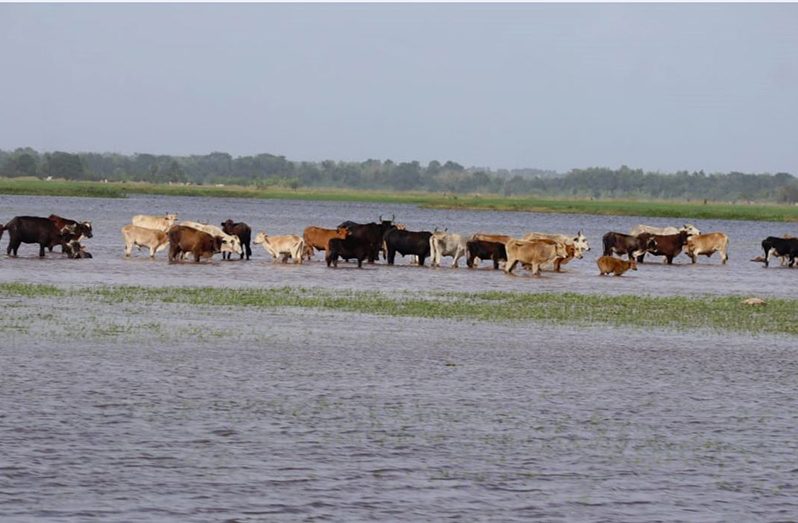PRESIDENT Dr. Irfaan Ali has officially declared Guyana to be in a state of disaster by virtue of the ongoing floods. In his proclamation recorded on Thursday, the Head of State noted that as at the morning of June 7, 2021, a total of 28,228 households were affected by flooding, some with water entering their homes, domestic animals and livestock in distress, or farmlands inundated.
“In pursuance of the powers conferred upon me by Article 99 of the Constitution of Co-operative Republic of Guyana, I do hereby declare a disaster in the Cooperative Republic of Guyana,” the official gazette reads.
Under Article 99 of the Constitution of Guyana, the Head of State is responsible for disaster management, and is authorised to declare a disaster for the State, on account that he is satisfied that a disaster has happened, is happening, or is likely to happen.
In accordance with the declaration, the Civil Defence Commission (CDC) has been permitted to exercise disaster-management powers, in an effort to prevent or minimise loss of human life, illness or injury to humans, property loss, or damage to the environment.

During a flood-relief outreach in Region Six (East Berbice – Corentyne), President Ali informed the residents of Chesney Village that he had been advised by the CDC that Guyana is now experiencing a Level Two disaster.
This classification was cited under the Caribbean Disaster Emergency Management Agency’s (CDEMA) mechanism, which indicates that the national capacity to respond is not overwhelmed, but external assistance is required in the form of technical assistance, specialised equipment, support personnel, and information sharing in order to respond and recover from the event.
Despite Guyana’s situation being classified as Level 2, the CDC, in a press statement issued on Saturday evening, said that the impact of the floods varies by region, with Regions One (Barima-Waini), Three (Essequibo Islands-West Demerara), Four (Demerara-Mahaica), Eight (Potaro-Siparuni) and Nine (Upper Takutu-Upper Essequibo), being at Level 2, being given national capacity to manage the impact.
Meanwhile, the devastating situation in Regions Two (Pomeroon-Supenaam), Five (Mahaica-Berbice), Seven (Cuyuni-Mazaruni), and 10 (Upper Demerara-Berbice) has progressed to a Level 3 disaster, based on the magnitude of the floods there. The CDC has noted that it is for this reason that regional and international support is needed to effectively mobilise resources in order to respond and recover from the impact of the floods.
“A Tropical Wave embedded within the Inter-Tropical Convergence Zone (ITCZ) is currently affecting Guyana, resulting in heavy rainfall, which could last until mid-July,” the CDC noted.
Since May 18, 2021, the CDC has received reports of more than 29,000 households suffering from flooding in more than 300 communities countrywide. To date, a total of 17,829 cleaning hampers, and 21,735 food hampers have been distributed across the regions as a form of emergency relief.
The CDC said that it continues to manage the shelters that have been set up in Regions Two, Nine, and 10; these have been housing a combined total of 205 residents who were displaced, as floodwaters began to enter their homes.
The Commission has indicated that based on President Ali’s declaration, efforts at the regional level to better coordinate response activities with it have been intensified.
Tomorrow, the National Assembly is likely to commence its debate on a $10 billion supplementary budget that is being sought by the government to tackle the effects of the ongoing floods, and its corresponding countrywide relief efforts. The monies, once approved, will be used to complement the supply of food, sanitary and medical hampers for those affected. It will also aid the emergency repairs to a number of public infrastructure, specifically roads and bridges, that have been damaged by the floodwaters.
A preliminary assessment of the infrastructural impact of floods has revealed a loss of billions of dollars in public infrastructure. An overall financial impact of the ongoing disaster is yet to be determined, and is likely to be the focus of a socio-economic impact assessment, once the waters have fully receded, and those affected begin to recover.
President Ali has repeatedly vowed to provide much-needed support to those whose livelihoods were destroyed by the natural disaster. “We will help you to get back on your feet,” Dr. Ali assured the nation.




.png)









